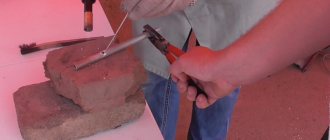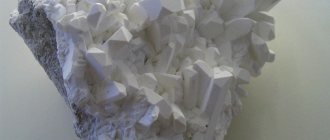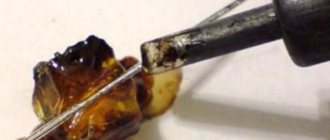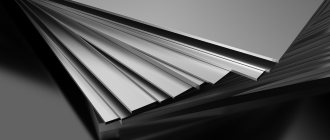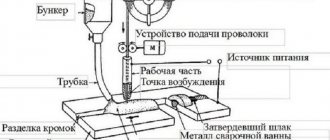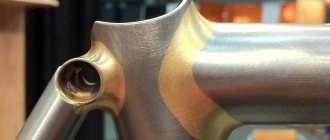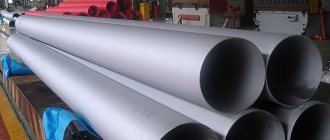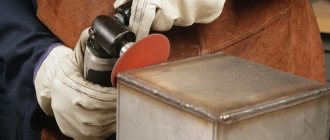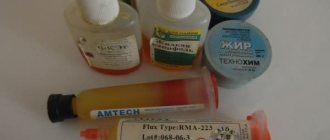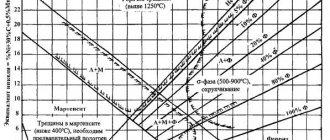Home > Tools > Soldering flux
The article provides answers to the questions: what are soldering fluxes for and what do they consist of? Almost all metals are naturally covered with an oxide film. It is this circumstance that becomes an obstacle to liquid solder. To overcome this obstacle, fluxes are used. What it is? This is a mixture of substances of organic and inorganic origin, which has the properties of removing oxides and reducing surface tension in solder areas. Such substances are called fluxes. In addition, the product promotes better spreading of liquid solder and protects the parts to be connected during soldering from the influence of the external environment.
Set of fluxes for soldering
Types of fluxes for soldering
The main property of soldering fluxes is its chemical neutrality with respect to solder. The substance may be in the form of a liquid, solid or paste. The main types of fluxes for soldering are presented in the following list:
- rosin;
- ammonia;
- borax;
- orthophosphoric acid;
- acetylsalicylic acid;
- fppu 25.
Rosin
For quick and high-quality soldering, rosin is used as a flux. The basis of the substance is pine resin with the addition of turpentine. The technical characteristics of rosin are determined by GOST 19113-84.
Rosin for soldering
The properties of pine resin as an auxiliary material for soldering have been known for a long time. Rosin, not having a crystalline structure, is an amorphous glassy fragile body. The translucent mass can be of different shades: from pale yellow to dark brown.
Rosin is hydrophobic, but easily dissolves in alcohol and acetone. Flux is widely used at home for soldering radio components, copper wiring and other things. The material has a low melting point. When heated above 700 C, the flux becomes liquid and is easily transferred by the soldering iron tip to the soldering site.
Soldering wires with rosin
If you need to solder two ends of the wires, proceed as follows:
- The ends of the wires are stripped of insulation. They do it with a knife;
- If the wire is stranded, then it is twisted into a pigtail by hand;
- The exposed wires are heated with a soldering iron;
- The soldering iron tip is dipped into rosin in order to then transfer the product to the metal;
- Using longitudinal movements of the tip, the pigtails of the wires are impregnated with flux;
- Then they put molten solder on the soldering iron tip;
- By running a soldering iron along the ends of the wires, the metal is tinned;
- Tinned braids are twisted together;
- A thin layer of molten tin is applied to the junction of the wires with a soldering iron tip.
Ammonia
The chemical compound ammonium chloride NH4Cl is known as ammonia. Ammonium salt looks like a white, odorless powder. Liquid flux is a solution of 77 parts salt in 100 parts water.
Ammonia is obtained as a by-product of soda production. At soldering temperatures (above 3380), ammonium chloride vapor completely decomposes into two compounds: NH3 and HCL.
Why are ammonia fluxes needed? They are used for tinning and soldering steel products. Ammonia, in contact with heated metal, decomposes into two substances: ammonia (NH3) and hydrochloric acid (HCL). The acid dissolves the metal oxide layer and cleans the soldering surface, ensuring 100% adhesion of the solder to the metal.
Plastic packaging with ammonia
On sale you can always find a solution or powder of ammonia intended for soldering. The flux is sold in convenient plastic packaging. The product is also used to clean soldering iron tips from carbon deposits and scale.
Borax
This substance is extracted from drying salt lakes. In addition, borax solder paste is obtained by neutralizing boric acid with sodium carbonate. The resulting mixture is dehydrated by evaporation followed by filtration of the solution.
To make soldering flux with your own hands, proceed as follows:
- boil the soda solution in a container, stirring it constantly;
- Having brought the solution to a boil, pour in boric acid granules, preventing the mixture from foaming;
- the solution is boiled for 30 minutes;
- then the mixture is cooled and filtered.
The result is a white crystalline powder. The resulting borax is a high-temperature flux that is used for soldering joints of cast iron, steel, and copper alloys. Prepare a borax paste by grinding the powder in a mortar and adding boric acid in a 1:1 ratio. To increase the chemical activity of the flux, chloride and fluoride salts are added to it. During soldering, a layer of salt will form that will need to be removed.
An example of soldering copper parts using borax
There are cases of failure of a water heating column or installation of a heated floor system and other water heating equipment. You need to connect the pipe to the fitting. In order to solder such a connection, proceed as follows:
- The end of the pipe and the inner surface of the fitting are cleaned with fine sandpaper;
- Borax in the form of solder paste is applied with a brush to the joints;
- The pipe is inserted into the fitting and turned slightly in both directions. This gives an even distribution of flux over the entire joint surface;
- Use a gas burner to heat the assembly from the outside so that the heat penetrates inside;
- A rod of soft solder is led along the seam, following the burner flame;
- Under capillary action, the solder will begin to penetrate deep into the neck of the fitting;
- Solder must be inserted from bottom to top in both directions;
- Soldering must not be cooled with water. The connection should cool naturally;
- Remains of flux are removed with a damp cloth.
Orthophosphoric acid
The formula of this inorganic substance looks like H3PO4. Acid is an effective rust remover. Along with this, phosphoric acid is used as a soldering flux.
Orthophosphoric acid
The acid is used for soldering low-alloy and carbon steels. The flux effectively removes the oxide film on both the base material and the solder. Rust, under the influence of acid, becomes loose and floats on the surface of the flux. A protective layer is formed at the cleaning site, which prevents the formation of a new oxide film. After soldering, all acid residues are easily washed off with warm water.
This flux is successfully used when soldering parts made of stainless steel, nickel and their alloys. Ferrous metal compounds are also treated with acid. In radio engineering, acid is not used because it can corrode contacts.
Acetylsalicylic acid
A situation may arise that you urgently need to solder the wire connections, restore contact in the electrical circuit, but there is no flux for soldering in the house. Don't despair. A regular aspirin tablet (acetylsalicylic acid) will help out.
Aspirin tablets
This is the case when you can make a soldering flux with your own hands. The wire processing process is as follows. The exposed section of the wire is pressed with a tinned soldering iron tip to an aspirin tablet. As a result of the movement of the soldering iron tip along the wire, the varnish on the metal is destroyed, and the conductor is covered with a thin layer of solder.
FPPU 25
There is a legend among people about a universal soldering agent that was used in military factories of the Soviet Union. What is FPPU 25 flux? This is a solder paste similar in composition to epoxy resin. The name of the product is the initial letters of the words: flux, universal soldering paste.
Tube FPPU 25
You can still find solid sealed pipes with this flux made in the Soviet Union. The paste is truly universal and suitable for soldering many metals. Its only and significant drawback is the toxic fumes that arise during soldering work. Working with such flux at home is extremely hazardous to health. Today on the market you can still find a soldering agent under this name.
Hardwired
Purpose of flux
| Brand | Appearance | Solderable metal or metal coating | Solders used | Purpose |
| Rosin grade A | Copper; silver, tin, zinc, tin-lead, tin-bismuth, gold coatings | Tin-lead, tin-lead-cadmium (at soldering temperatures above 220°C), silver PSr1.5 and PSr2 | Manual and mechanized soldering and tinning of mounting elements and other surfaces. Preservation of the product to preserve solderability under warehouse storage conditions. | |
| FKSp (FKEt) | Light brown liquid | Same | Same | The same, as well as soldering of conductors with insulation in the form of tubes or enamel insulation, products with increased requirements for insulation resistance |
| FCDT | Dark brown liquid | Copper; silver, tin, tin-lead, tin-bismuth, gold coatings | Tin-cadmium-indium, tin-lead, tin-lead-bismuth, tin-lead-cadmium, indium | Manual and mechanized soldering and tinning of mounting elements and other surfaces. |
| LTI-120 | Dark brown liquid with slight sediment | Carbon steel, copper and its alloys, nickel and its alloys; tin, silver, cadmium, zinc, tin-lead, tin-bismuth coatings | Tin-lead, silver PSr1.5 and PSr2 | Manual and mechanized soldering and tinning of mounting elements that do not have insulation in the form of tubes on the terminals, and other surfaces in widely used products. |
| FGSp, FSkSp, FSkPs | FGSp, FSkSp – colorless liquid; FSkPs – homogeneous paste of light yellow color | Copper and its alloys, nickel and its alloys; tin, silver, cadmium, zinc, tin-lead, tin-bismuth coatings | Tin-lead, tin-lead-bismuth, tin-lead-cadmium | Manual (FSkPs and FSkSp) and mechanized soldering and tinning of mounting elements that do not have insulation on the terminals in the form of tubes and other metal surfaces in widely used products |
| FCS | Yellow liquid | Copper; tin, silver, cadmium, zinc, tin-lead, tin-bismuth coatings | Tin-lead, tin-lead-bismuth, tin-lead-cadmium | Manual and mechanized soldering and tinning of mounting elements and other metal surfaces in consumer products |
| FDGL | Colorless thick liquid. At soldering temperature – brown | Same | Tin-lead | Manual and mechanized soldering and tinning of consumer products. Group soldering by immersion in soldering flux at a temperature of 220–250°C and melting of electrolytically tin-coated parts before soldering |
| FCA | Colorless liquid | Copper and its alloys (including BrB), carbon and stainless steels, nickel and its alloys | Tin-lead and low temperature silver | Pre-tinning (mechanized and manual) and soldering of products, subject to complete removal (using neutralizing solutions) of flux residues after soldering, except for mounting connections |
| FDFs | Colorless liquid | Steel, chromium-nickel alloys (nichrome, permalloy, superinvar, kovar, invar), copper and its alloys | Tin-lead | Manual and mechanized soldering and tinning of products, except for mounting connections |
| ZhZ-1-AP, ZhZ-2-AP | Viscous dark brown liquid | Tin-lead | Protection of the molten solder surface from oxidation in mechanized soldering installations | |
| 284, 209 | White powder | Copper and its alloys, stainless and structural steels, heat-resistant alloys | Silver | Soldering of electronic components and various structures using gas-flame heating and in furnaces |
| 200 | White powder | Stainless and structural steels, heat-resistant alloys | Brass and solders with a melting point of 850–1000°C | Soldering of electronic components and various structures using gas-flame heating and in furnaces |
| 34A, F370A | White powder | Aluminum and its alloys, except alloys with magnesium content above 3% | Aluminum | Soldering of electronic components |
| 16VK | Aluminum and its alloys | Aluminum | Soldering of electronic components. Group soldering of components by immersion in a salt bath |
Flux composition. Removing flux residues
| Brand | Composition (weight) | Removing flux residues after soldering | |
| Component | % | ||
| FKSp (FKEt) | Pine rosin | 10 – 60 | Ethyl alcohol or alcohol-gasoline mixture 1:1 |
| Ethyl alcohol or ethyl acetate | 90 – 40 | ||
| FCDT | Pine rosin | 10 – 20 | |
| Dimethylalkylbenzyl ammonium chloride (kitamine AB) | 0,1 – 3,0 | ||
| Tributyl phosphate | 0,01 – 0,10 | ||
| Ethyl alcohol or ethyl acetate | 89,89 – 76,90 | ||
| LTI-120 | Pine rosin | 20 – 25 | |
| Diethylamine hydrochloride | 3 – 5 | ||
| Triethanolamine | 1 – 2 | ||
| Ethanol | 76 – 68 | ||
| FGSSp | Hydrazine hydrochloride | 2 – 4 | Hot running water (70±10°C) or alcohol-gasoline mixture 1:1 |
| Ethylene glycol or glycerin | 25 – 50 | ||
| Ethanol | 73 – 46 | ||
| FSkSp | Semicarbazide hydrochloride | 2 – 4 | |
| Ethylene glycol or glycerin | 25 – 50 | ||
| Ethanol | 73 – 46 | ||
| FSkPs | Semicarbazide hydrochloride | 3 – 5 | |
| Glycerol | 70 – 58 | ||
| Polyox-100 or Polyox-115 | 27 – 37 | ||
| FCS | Salicylic acid | 4,0 – 4,5 | Alcohol-gasoline mixture 1:1 |
| Triethanolamine | 1,0 – 1,5 | ||
| Ethanol | 95 – 94 | ||
| FDGL | Diethylamine hydrochloride | 4 – 6 | Hot running water (70±10°C) |
| Glycerol | 96 – 94 | ||
| FCA | Zinc chloride | 45,5 | Hot running water (70±10°C) and neutralizing reagents |
| Ammonium chloride | 9 | ||
| Water | 45,5 | ||
| Zinc oxide hydrate | Before precipitation occurs | ||
| FDFs | Diethylamine hydrochloride | 20 – 25 | Hot running water (70±10°C) or alcohol-gasoline mixture 1:1 |
| Ethylene glycol | 60 – 50 | ||
| Phosphoric acid (specific gravity 1.7) | 20 – 25 | ||
| ZhZ-1-AP | Cylinder oil “52” or “KS-19” | 79 – 81 | Alcohol-gasoline mixture 1:1, trichlorethylene, acetone |
| Organosilicon liquid PFMS-6 | 16 – 17 | ||
| Oleic acid | 4,9 – 1,8 | ||
| Antioxidant NG-2246 | 0,1 – 0,2 | ||
| ZhZ-2-AP | Cylinder oil “52” or “KS-19” | 58,52 – 69,75 | |
| Organosilicon liquid PFMS-6 | 21,65 – 10,66 | ||
| Cottonseed oil | 11,0 – 10,64 | ||
| Oleic acid | 8,79 – 9,02 | ||
| Antioxidant NG-2246 | 0,04 – 0,03 | ||
| 284 | Boric anhydride | 23 – 27 | Hot running water (70±10°C) and cold running water |
| Potassium fluoride | 33 – 37 | ||
| Potassium borofluoride-hydrogen | 44 – 36 | ||
| 209 | Boric anhydride | 33 – 37 | |
| Potassium fluoride | 40 – 44 | ||
| Potassium borofluoride-hydrogen | 27 – 19 | ||
| 200 | Boric anhydride | 70 – 62 | Hot flow and neutralizing reagents |
| Sodium tetraborate (borax) | 17 – 21 | ||
| Calcium fluoride | 13 – 17 | ||
| 34A | Potassium chloride | 56 – 44 | |
| Lithium chloride | 29 – 35 | ||
| Zinc chloride | 6 – 10 | ||
| Sodium fluoride | 9 – 11 | ||
| F370A | Potassium chloride | 51 – 46 | |
| Lithium chloride | 36 – 39 | ||
| Sodium fluoride | 4 – 5 | ||
| Cadmium chloride | 9 – 10 | ||
| 16VK | Sodium chloride | 12 | |
| Potassium chloride | 44 | ||
| Lithium chloride | 34 | ||
| Eutectic (aluminum fluoride – 54%, potassium fluoride – 46%) | 10 | ||
Table 3 influence of flux residues on insulation and their corrosive effect
| Brand | Effect of flux residues on insulation resistance | Corrosive effect of flux residues | |||
| for copper | for silver plating | on tin-lead coating | for nickel coating | ||
| FKSp (FKEt), FKDT | do not affect | do not provide | |||
| LTI-120, FGSp, FSkSp | reduce | provide | do not provide | ||
| FSkPs | reduce | provide | do not provide | provide | do not provide |
| FCS | reduce | have a weak | do not provide | ||
| FDGL | reduce | provide | have a weak | do not provide | n/a |
| FDFs | reduce | provide | do not provide | do not provide | provide |
| FCA | reduce | provide | |||
| ZhZ-1-AP, ZhZ-2-AP | do not affect | do not provide | — | ||
When soldering copper conductors, as well as grounding conductors to the armor and lead sheath of cables, use solder paste of the following composition (in weight parts):
- Rosin…………………………………….. 10;
- Animal fat………………………………. 3;
- Ammonium chloride ………………………… 2;
- Zinc chloride…………………………….. 1;
- Water or rectified ethyl alcohol.. 1.
For the same purposes, the following composition is often used for solder paste:
- Rosin……………………………………… 2.5%;
- Salo ……………………………………………. 5 %;
- Zinc chloride……………………………20%;
- Ammonium chloride …………………………. 2%;
- Technical Vaseline……………………… 65.5%;
- Distilled water………………….. 5%.
Flux for soldering aluminum
| Brand | Compound, % | Melting point, °C | |||||
| Potassium chloride | Sodium chloride | Lithium chloride | Sodium fluoride | Cryolite grade K-1 | Magnesium chloride | ||
| YOU | 50–55 | 30–35 | — | — | 10–20 | — | 630 |
| AF-4A | 50 | 28 | 14 | 8 | — | — | » 600 |
| HP | 50 | — | 30 | — | — | 20 | |
VAMI flux is used for terminating wire and cable cores, AF-4A flux is used only for connecting cable cores in couplings.
Fluxes for soldering with soft and semi-hard solders according to electrical standards 0AA.614.017-67 and 0AA.614.028-68
| Brand | Purpose | Compound | Cleaning after soldering | |
| Component | % | |||
| TO | Tinning and soldering of current-carrying parts made of copper and its alloys | Pine rosin | 100 | Not required |
| KSP | Tinning and soldering of current-carrying parts made of copper and its alloys | Pine rosin | 25 | Not required |
| Technical ethyl alcohol grade B | 75 | |||
| FPP | Tinning and soldering of current-carrying parts made of copper and its alloys | Polyester resin grade PA9 | 20–30 | Not required |
| Methyl ethyl ketone or ethyl acetate | 80–70 | |||
| STUZO-12224-61 | Tinning and soldering of current-carrying parts made of copper, nickel and their alloys and parts coated with copper, tin, cadmium, silver and zinc | Pine rosin | 20–35 | Swab or brush soaked in solvent or alcohol |
| Diethylamine hydrochloride | 3–5 | |||
| Triethanolamine | 1–2 | |||
| Technical ethyl alcohol grade B | 76–68 | |||
| F59A 0AA.614.017-67 | Tinning and soldering of aluminum and AMts alloy with each other and with copper and its alloys | Cadmium borofluoride | 10 | Running hot water or alcohol |
| Zinc borofluoride | 3 | |||
| Ammonium borofluoride | 5 | |||
| Triethanolamine | 82 | |||
| 34A 0AA.614.017-67 | Soldering of aluminum and its alloys (melting point 420 °C) | Cadmium fluoride | 50±6 | Hot, then cold running water |
| Lithium chloride | 32±6 | |||
| Zinc chloride | 8±2 | |||
| Sodium fluoride | 10±1 | |||
| LM1 | Tinning and soldering of iron-nickel alloys and stainless steels | Pine rosin | 20–35 | Swab or brush soaked in solvent or alcohol |
| Diethylamine hydrochloride | 3–5 | |||
| Triethanolamine | 1–2 | |||
| Technical ethyl alcohol grade B | 76–78 | |||
| F38N | Tinning and soldering nichrome between itself and copper | Diethylamine hydrochloride | 25–30 | Hot water or a brush dipped in alcohol |
| Ethylene glycol | 60–50 | |||
| Phosphoric acid | 29–25 | |||
How to solder correctly
How to tin a soldering iron: preparation and care of the soldering iron
This chapter will talk about how to properly solder simple connections of metal parts. In order to obtain high-quality soldering, you need to follow certain rules. A summary of these rules is reflected in the following paragraphs:
- A soldering iron, a small sponge or rag, solder, tweezers and wire cutters are laid out on the table;
- The soldering iron is connected to the mains, trying to melt the solder;
- The end of the tip is covered with molten solder;
- The ends of the wires are removed from the insulation using wire cutters;
- Using short movements with a sponge, remove the remains of old tin from the surface of the heated tip;
- The areas to be soldered are tinned with solder using a soldering iron, alternately dipping the tip into a mass of flux (rosin or other flux);
- Clamping the ends of the wire together with tweezers, apply solder to the tinned areas. If the wires are of small diameter, then their ends are simply twisted and then soldered;
- After the soldering area has cooled, check the connection for strength;
- Remove flux residues with a cotton swab dipped in alcohol or acetone.
There is no need to master the technique of soldering printed circuit boards on your own. It is best to gain experience in this matter in direct contact with the master. It is the specialist who will teach you in a short time the soldering technique, the correct choice of soldering equipment and the selection of the required flux.
